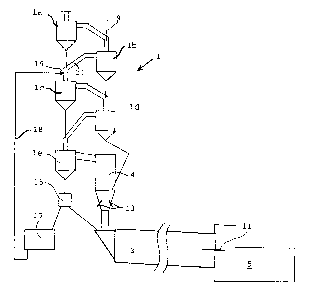Some of the information on this Web page has been provided by external sources. The Government of Canada is not responsible for the accuracy, reliability or currency of the information supplied by external sources. Users wishing to rely upon this information should consult directly with the source of the information. Content provided by external sources is not subject to official languages, privacy and accessibility requirements.
Any discrepancies in the text and image of the Claims and Abstract are due to differing posting times. Text of the Claims and Abstract are posted:
| (12) Patent Application: | (11) CA 2375001 |
|---|---|
| (54) English Title: | METHOD AND APPARATUS FOR DESULPHURISATION OF EXHAUST GASES |
| (54) French Title: | PROCEDE ET APPAREIL DE DESULFURATION DE GAZ D'ECHAPPEMENT |
| Status: | Deemed Abandoned and Beyond the Period of Reinstatement - Pending Response to Notice of Disregarded Communication |
| (51) International Patent Classification (IPC): |
|
|---|---|
| (72) Inventors : |
|
| (73) Owners : |
|
| (71) Applicants : |
|
| (74) Agent: | BORDEN LADNER GERVAIS LLP |
| (74) Associate agent: | |
| (45) Issued: | |
| (86) PCT Filing Date: | 2000-06-16 |
| (87) Open to Public Inspection: | 2000-12-28 |
| Availability of licence: | N/A |
| Dedicated to the Public: | N/A |
| (25) Language of filing: | English |
| Patent Cooperation Treaty (PCT): | Yes |
|---|---|
| (86) PCT Filing Number: | PCT/EP2000/005880 |
| (87) International Publication Number: | EP2000005880 |
| (85) National Entry: | 2001-11-22 |
| (30) Application Priority Data: | ||||||
|---|---|---|---|---|---|---|
|
Described is a method and apparatus for desulphurisation of exhaust gases from
a cement making plant by bonding gaseous sulphur dioxide to calcium-containing
cement raw meal which is extracted from the calcination stage (4) of the plant
and subsequently brought into contact with the exhaust gases as a sulphur-
absorbing reactant. The specific method slaking and grinding the extracted raw
meal prior to it being brought into contact with the exhaust gases. By this
method and apparatus an improvement of the thermal economy, is obtained by
reducing the quantity of raw meal required for the desulphurisation process.
This is ascribable to the fact that by subjecting the raw meal to slaking and
grinding, the fineness of the raw meal will be improved, thereby enhancing the
efficiency of the desulphurisation process.
L'invention concerne un procédé et un appareil de désulfuration de gaz d'échappement provenant d'une installation de fabrication de ciment, qui consiste à lier du gaz sulfureux à un cru de ciment contenant du calcium, extrait de l'étape de calcination (4) de l'installation et à le mettre en contact avec les gaz d'échappement sous forme de réactif absorbant le soufre. Le procédé de l'invention consiste notamment à désagréger et à broyer le cru extrait avant qu'il soit mis en contact avec les gaz d'échappement. Grâce aux procédé et appareil de l'invention, on augmente l'économie d'énergie thermique en réduisant la quantité de cru requise pour le procédé de désulfuration. En effet, en soumettant le cru à la désagrégation et au broyage, on augmente la finesse du cru et on augmente ainsi l'efficacité du procédé de désulfuration.
Note: Claims are shown in the official language in which they were submitted.
Note: Descriptions are shown in the official language in which they were submitted.

2024-08-01:As part of the Next Generation Patents (NGP) transition, the Canadian Patents Database (CPD) now contains a more detailed Event History, which replicates the Event Log of our new back-office solution.
Please note that "Inactive:" events refers to events no longer in use in our new back-office solution.
For a clearer understanding of the status of the application/patent presented on this page, the site Disclaimer , as well as the definitions for Patent , Event History , Maintenance Fee and Payment History should be consulted.
| Description | Date |
|---|---|
| Time Limit for Reversal Expired | 2005-06-16 |
| Application Not Reinstated by Deadline | 2005-06-16 |
| Deemed Abandoned - Failure to Respond to Maintenance Fee Notice | 2004-06-16 |
| Letter Sent | 2002-05-17 |
| Inactive: Cover page published | 2002-05-13 |
| Inactive: Notice - National entry - No RFE | 2002-05-08 |
| Inactive: Applicant deleted | 2002-05-08 |
| Application Received - PCT | 2002-04-08 |
| Inactive: Single transfer | 2002-01-24 |
| National Entry Requirements Determined Compliant | 2001-11-22 |
| Application Published (Open to Public Inspection) | 2000-12-28 |
| Abandonment Date | Reason | Reinstatement Date |
|---|---|---|
| 2004-06-16 |
The last payment was received on 2003-06-10
Note : If the full payment has not been received on or before the date indicated, a further fee may be required which may be one of the following
Patent fees are adjusted on the 1st of January every year. The amounts above are the current amounts if received by December 31 of the current year.
Please refer to the CIPO
Patent Fees
web page to see all current fee amounts.
| Fee Type | Anniversary Year | Due Date | Paid Date |
|---|---|---|---|
| Basic national fee - standard | 2001-11-22 | ||
| MF (application, 2nd anniv.) - standard | 02 | 2002-06-17 | 2001-12-21 |
| Registration of a document | 2002-01-24 | ||
| MF (application, 3rd anniv.) - standard | 03 | 2003-06-16 | 2003-06-10 |
Note: Records showing the ownership history in alphabetical order.
| Current Owners on Record |
|---|
| F L SMIDTH & CO. A/S |
| Past Owners on Record |
|---|
| KENT THOMSEN |
| SOREN HUNDEBOL |